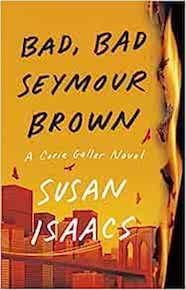
In 1970, I left my job as an editor at Seventeen magazine to stay in the suburbs and raise my kids. I was glad to go, though I missed the camaraderie of being in an office. Nevertheless, I’d had enough of “How to Write a Letter To a Boy.”
Those first few years passed quickly, what with being a mom and wife, writing an occasional magazine article, freelancing speeches for politicians from the Bronx and Queens who were relentless in trying to get me to write them “something JFK-ish” as we prepped for a confab on rodent control. Naturally I also wallowed in Watergate.
But I had something more going. My occasional practice of picking up a mystery morphed into a daily habit. I read four or five a week. Then came that epiphanic I think I can do this! moment.
What became Compromising Positions probably had been stewing in my nonconsciousness for ages because, within nanoseconds, I knew my detective would be an erstwhile academic who had put her career on hold to raise her kids. A best friend? Check. A husband incapable of fully appreciating her wonderfulness? Yup. I needed a homicide murder victim so, still feeling the sting of recent gum surgery, I figured who better to die than a periodontist. The setting? I don’t know if I was following the hoary advice to newbies — Write about what you know — or choosing what felt genuine, but Long Island rose up with the characters.
I put some paper in the typewriter. Nothing much happened except rising spikes in my anxiety level. After a couple of months, I noticed I was hyperventilating each weekday morning, so I hit the library. It was the go-to in pre-Internet days. I prayed some novelist/compassionate soul/capitalist had sensed a demand and written a how-to-write-a-novel guide. And indeed, I found John Braine’s How to Write a Novel[i]. Like the Montessori method of tying a shoelace, it broke down a complex task into a series of easily-accomplished steps. It happened too long ago to recollect all his suggestions, but I remember making a list of characters’ names and typing an outline of no more than three pages.
[Brief aside time: Some writers recoil at this notion of planning. They demand their freedom. Okay, then they should grab it — while understanding they risk a work that feels unstructured, or one that simply takes up residence on a bunch of neurons and never ventures out into the world. On the other hand, they may be rewarded for their faith in their own spontaneity. Writing a novel is an idiosyncratic act, like making chicken soup or making love. No two people do it the same way.]
John Braine’s guide allowed me to envision each work as a whole and also to maneuver its parts. Knowing I had a beginning, middle, and end took away some of the terror. Also, since I was the creator, I could revise or toss whatever didn’t work.
After forty-plus years in the fiction business, after fourteen diverse novels and a novella — mysteries, espionage, sagas, coming-of-age stories — I decided it was time for a series. My first novel had been my first attempt at fiction. It had been a surprise (to me) success, and while a series at that point might have been a wiser career move, I kept picturing twenty years down the road writing Compromising Positions Goes Hawaiian. Instead, I had a go at all the types of stories I cared about. Now I was ready for a deeper, more long-lasting relationship with my characters.
John Braine never wrote How to Write a Crime Fiction Series, but by the time I began what would be the Corie Geller books, I realized I needed a plan. It had to be authentic: no Amateur Night, with an audacious housewife stumbling onto one homicide after another … Ooh, look. Another dead body! The main character had to be a pro. Corie had left the FBI after a career in anti-terrorism. She is fluent in Arabic, competent in Spanish, kickass in Krav Maga, with intuitive empathy, street smarts, and training that makes her a gifted interrogator. And while she is skilled at talking her way out of sticky situations, she can also fight her way out.
The same with the other major characters: her dad, a retired NYPD homicide detective; her mom, an actor whose career high was a half-season on a soap opera; her husband, a federal district judge; her lifelong best friend, a style guru; her teenage daughter, still a work in progress. I wanted a nucleus of characters with lively interests but different varieties of savvy. It was vital that Corie and company were compelling enough to keep me and my readers invested in their lives.
The already-published Corie Geller books, Takes One to Know One and Bad, Bad Seymour Brown, are not just two in a series of novels; they are mysteries that require a dynamic plot and an OMG! ending. For that, I can stick to my MO: making a plan using what I learned from How to Write a Novel combined with my own tricks of the trade.
Sadly Braine’s book is out of print now. Appallingly there is no digital version. But I recently ordered a used hardcover edition to replace the paperback I’d foolishly lent out. Because even though I need silence to work, I want the company of books that talk to me.
[i] I believe it's called Writing a Novel in the UK

BAD, BAD SEYMOUR BROWN is published by Grove Press UK, £14.99